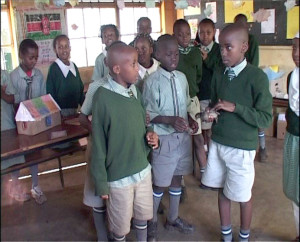 As a non-native to this country and as an academic who moved to the Midwest from Israel a few years ago, I often have been baffled by what seems to be a very ethnocentric view applied when American journalists and academics relate to the rest of the world. For example, in my role as an editor of an international academic journal, I find myself routinely calling to the attention of U.S.-based authors that expressions such as “the Midwest,” “over Christmas break,” “in the summer” or even “third-graders” are inherently cultural.
As a non-native to this country and as an academic who moved to the Midwest from Israel a few years ago, I often have been baffled by what seems to be a very ethnocentric view applied when American journalists and academics relate to the rest of the world. For example, in my role as an editor of an international academic journal, I find myself routinely calling to the attention of U.S.-based authors that expressions such as “the Midwest,” “over Christmas break,” “in the summer” or even “third-graders” are inherently cultural.
I challenge them with questions about what such concepts would mean to a reader in a different country: The Midwest – of what? What about the readers who do not celebrate Christmas and who do not have a “break”? What are the implications of the fact that summers in the Northern Hemisphere are winters in the Southern Hemisphere? Since educational systems around the world start mandatory schooling at different ages, there will be significant developmental and cultural differences if the “third-graders” are 7, 8 or 9 years old. We often assume that the language with which we describe our world is neutral, when in fact we need to be reminded that it is culturally laden.
News coverage of the world certainly is one central sphere in which our comfortable tendency for ethnocentrism can be unsettled. It is through such exposure that people who do not have the privilege of traveling widely encounter other cultures, ways of living, belief systems, political institutions, languages and concepts.ge them with questions about what such concepts would mean to a reader in a different country: The Midwest – of what? What about the readers who do not celebrate Christmas and who do not have a “break”? What are the implications of the fact that summers in the Northern Hemisphere are winters in the Southern Hemisphere? Since educational systems around the world start mandatory schooling at different ages, there will be significant developmental and cultural differences if the “third-graders” are 7, 8 or 9 years old. We often assume that the language with which we describe our world is neutral, when in fact we need to be reminded that it is culturally laden.
So how much of that coverage appears in the news? A book published this year, titled “Foreign news on television: Where in the world is the global village?” deals with this question. It was written by Peter Lang and edited by Akiba Cohen, an internationally prominent news researcher from Israel and a longtime colleague of mine. The book presents findings from a comparative study of news coverage in 17 countries, including the United States, that include analyses of 17,000 news items and 10,000 survey respondents. The subtitle of the book is what attracted me most – and indeed the edited collection shows, as the endorsement on the back cover highlights, “that while globalization is a dominant force in society, and though news can be instantaneously broadcast internationally, there is relatively little commonality throughout the world in the depiction of events occurring in other countries.
Thus, contrary to Marshall McLuhan’s famous, but untested, notion of the ‘global village,’ television news in the countries discussed in this book actually presents more variability than similarity.” Clearly, news organizations report foreign news from their points of view on what they believe to be of importance for their local audience – a process referred to in media studies as “domestication.”
The U.S.-based part of the study analyzed two representative television news programs – “NBC Nightly News” as a popular broadcast news program and “News-Hour with Jim Lehrer” representing public broadcasting. Based on analyses of television foreign news coverage in these programs, the United States ranked among the lowest of the 17 nations studied: 68 percent of the broadcast news is purely domestic, and an additional 4 percent is domestic with foreign involvement. While foreign news comprised just 12 percent of U.S.-based television news, an additional 15 percent of the foreign-related news had domestic involvement. In comparison, news coverage in Canada was found to consist of 33 percent purely domestic, 23 percent domestic with foreign involvement, 31 percent purely foreign, and 13 percent foreign with domestic involvement.
Stimulating more interest in foreign news goes well beyond a matter of curiosity and general education. Those of us involved in higher education, economy, politics or cultural industries realize too well that cultivating global awareness and responsibility has become an urgent need for survival and development of all aspects of our societies.
I do not accept the claim that Midwesterners in the United States are not interested and do not care about the rest of the world, and I reject the often-cited “axiom” that “we give the audience what they want.” Indeed, I found evidence supporting this claim when hundreds of children and their families in southern Illinois participated in a special program in their local libraries in collaboration with the College of Mass Communication and Media Arts at Southern Illinois University (for which I serve as the interim dean). A selection of children’s award-winning television programs from around the world and presented at the Prix Jeunesse International festival in Munich, Germany, were screened at their hometown libraries, supported by opportunities to hear the views of international students from SIU in discussion of life in other cultures, as represented in these television programs.
Among others, they watched a program about bullying and a boy’s compassionate care of a chick in Kenya (“Chick Chick,” Kenya Television Network); interviews with children in Mexico retelling their dreams (“Once I dreamt …” from Once TV Mexico); the persistence of a boy working with tourists in a historical town in East Turkey to fulfill his dream of buying his own bike (“My Dream Bike,” TRT Istanbul TV); the emotional growth of a Chinese boy delivering letters in a small mountain town (“The Story of a Letter,” China Central Television); and a boy’s effort to save a goldfish in Iran (“Ponds of Mirror,” Islamic Republic of Iran Broadcasting).
The interest, enthusiasm and curiosity about the world these screenings raised among children and adults in the remote towns of rural southern Illinois should inspire us all to rethink our approach to foreign news coverage. There is great potential to cultivate an intelligent and engageable audience, as there seems to be a thirst to be connected to the wider world.
The news media can be a central route to engaging this thirst for the foreign among U.S. audiences. This can be achieved by domesticating world events and making them relevant to local populations; by pointing out how local issues – social, environmental and economical – are connected to the wider world; by bridging our multicultural populations with their countries of origins; by highlighting shared human interests and concerns; and by reminding us that we are all members of a much larger globe than our own region – or even country.
Dafna Lemish is a professor and interim dean of the College of mass Communication and Media Arts at SIUC.

